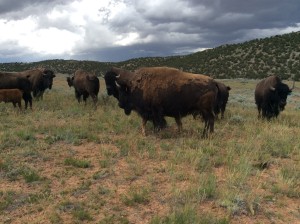 http://westerndigs.org/2500-year-old-bison-kill-site-offers-new-clues-into-ancient-culture-of-northern-plains/
http://westerndigs.org/2500-year-old-bison-kill-site-offers-new-clues-into-ancient-culture-of-northern-plains/
Around 2,500 years ago, just north of the Montana border in Alberta, two groups of prehistoric hunters from what archaeologists call the Besant Culture and the Sonota Culture surrounded a marsh. The marsh nestled in the midst of sand dunes left over from the retreat of the enormous lakes that had existed during the Pleistocene Ice Age, 8,000 years before. Bison were grazing the marsh.
The hunters carefully set up their ambush. It must have been similar to hunting bison in snowdrifts. Bogged down, slogging through the mud, the bison couldn’t run as fast, making them easy prey. The hunters were using atlatls, spear throwers, and spears about as long as they were tall. Both groups had probably recently been in what is today North Dakota, because 75% of their spear points were made from a unique flint native only to the Dakotas, Knife River flint.
Launching a spear with an atlatl gives a hunter about two-hundred times the energy of throwing a spear by hand. They likely sneaked through the grass until they were close enough, then raised their weapons and cast their spears in a coordinated attack. The ambush was very effective. They killed and butchered 65 bison. In the process, they lost 118 spear points, which were recovered during the archaeological excavations that took place between 2004-2012. When the excavations were over, archaeologists had catalogued over 200,000 fragments of bison bone.
But the most interesting things about this site were the mysterious bison bone sculptures, features called bone “uprights,” meaning bones that have been deliberately set on end by human beings. Uprights served a variety of purposes: to prop a pot over hot coals, serve as the rib-like frame of a lodge, stake down a tipi bottom, peg hides for fleshing, etc. They are rare discoveries in archaeological sites. But the bone sculptures at the Fincastle site were more than rare, they were incredible one-of-a-kind finds.
To create one of the most intriguing sculptures, the hunters took four bison jaw bones and one lower leg bone (tibia), stood them on end to form a unique display, then buried it, or shoved it in the ground. Was it an artistic act designed to honor the sacred remains of the bison that sustained their peoples? Maybe. But since the buried sculptures would not have been visible to human beings walking the ground surface, they may also have been offerings to ancestors living in the underworld Land of the Dead, possibly thanking them for the gift of the bison.
No one will ever know for certain, but hopefully future excavations of Besant and Sonoto sites will shed further light on these fascinating discoveries.
Read more about it:
Bubel, S. (2014). The Fincastle site: A Late Middle Prehistoric bison kill on the Northwestern Plains. Plains Anthropologist, 59 (231), pp. 207-240. DOI:10.1179/2052546X14Y.0000000009.
 Wonder why so many people are concerned with the Dept. of Interior’s plan to release Yellowstone bison to freely roam the public lands across the western United States? Even if they release bison without brucellosis (and 40% of bison cows in Yellowstone test positive for brucellosis) the disease is now endemic in the elk population, and many bison, including those in Yellowstone, will contract the disease from elk. Bison on ranches are vaccinated for this disease. However, there is no plan to vaccinate these wild bison, or to care for them if they become sick. If people are eventually allowed to hunt these wild bison, and eat their meat, here’s why you should care:
Wonder why so many people are concerned with the Dept. of Interior’s plan to release Yellowstone bison to freely roam the public lands across the western United States? Even if they release bison without brucellosis (and 40% of bison cows in Yellowstone test positive for brucellosis) the disease is now endemic in the elk population, and many bison, including those in Yellowstone, will contract the disease from elk. Bison on ranches are vaccinated for this disease. However, there is no plan to vaccinate these wild bison, or to care for them if they become sick. If people are eventually allowed to hunt these wild bison, and eat their meat, here’s why you should care:  http://www.sci-news.com/archaeology/science-stone-tools-butchered-elephant-bones-revadim-israel-02620.html
http://www.sci-news.com/archaeology/science-stone-tools-butchered-elephant-bones-revadim-israel-02620.html

 http://westerndigs.org/2500-year-old-bison-kill-site-offers-new-clues-into-ancient-culture-of-northern-plains/
http://westerndigs.org/2500-year-old-bison-kill-site-offers-new-clues-into-ancient-culture-of-northern-plains/